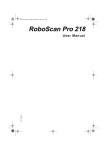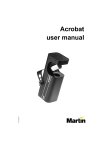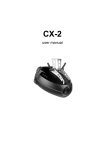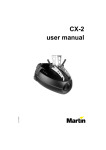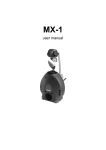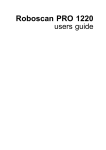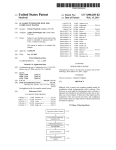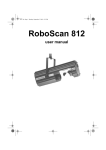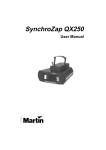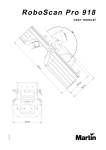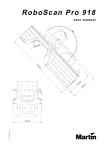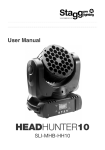Download RoboScan Pro 518
Transcript
RoboScan Pro 518 user manual © 1998-2000 Martin Professional A/S, Denmark. All rights reserved. No part of this manual may be reproduced, in any form or by any means, without permission in writing from Martin Professional A/S, Denmark. Printed in Denmark. P/N 35000059 Rev. D section 1 Introduction RoboScan Pro 518 Safety Information .................................................................4 Features ...............................................................................................................5 Accessories ..........................................................................................................5 section 2 Installation Installing and Changing the Lamp ........................................................................6 Checking Voltage and Frequency Settings ..........................................................6 Installing a Plug on the Power Cord .....................................................................7 Releasing the Pan/Tilt Lock ..................................................................................7 Rigging .................................................................................................................7 Setup for Controller Operation ..............................................................................8 section 3 Operation Stand-Alone Operation .......................................................................................10 Controller Operation ...........................................................................................10 Focus ..................................................................................................................12 Operating with Martin Controllers .......................................................................12 section 4 Service and Maintenance Adjusting the Lamp .............................................................................................13 DMX Mode Selection ..........................................................................................14 Selecting Voltage and Frequency .......................................................................15 Adjusting the Mirror ............................................................................................16 appendix a DMX 512 Protocol ..........................................................................................................................18 appendix b Specifications ...........................................................................................................................21 appendix c Exterior View ..........................................................................................................................22 appendix d DIP-Switch Table ..........................................................................................................................23 3 section 1 INTRODUCTION Thank you for purchasing the Martin RoboScan Pro 518 moving-mirror intelligent projector. It is designed, built, and programmed to be bright, reliable, safe and easy to use. With proper setup and maintenance, the RoboScan Pro 518 will provide years of trouble-free operation. This manual covers the RoboScan Pro 518 with software version 6.4. The latest information on the RoboScan Pro 518 is always available from your dealer and the Martin web site at http://www.martin.dk. RoboScan Pro 518 Safe ty In formation WARNING! This product is for professional use only. It is not for household use. This product presents risks of lethal or severe injury due to fire and heat, electric shock, ultraviolet radiation, lamp explosion, and falls. Read this manual before powering or installing the fixture, follow the safety precautions listed below and observe all warnings in this manual and printed on the fixture. If you have questions about how to operate the fixture safely, please contact your Martin dealer or call the Martin 24-hour service hotline at +45 70 200 201. To p r o t e c t y o u r s e l f a n d o t h e r s f r o m e l e c t r i c s h o c k • • • • • Disconnect the fixture from AC power before removing or installing the lamp, fuses, or any part, and when not in use. Always ground (earth) the fixture electrically. Use only a source of AC power that complies with local building and electrical codes and has both overload and ground-fault protection. Do not expose the fixture to rain or moisture. Refer any service operation not described in this manual to a qualified technician. To p r o t e c t y o u r s e l f a n d o t h e r s f r o m U V r a d i a t i o n a n d lamp explosion • • • • 4 Never operate the fixture with missing or damaged lenses and/or covers. When replacing the lamp, allow the fixture to cool for at least 5 minutes before opening the fixture or removing the lamp. Protect your hands and eyes with gloves and safety glasses. Do not stare directly into the light. Never look at an exposed lamp while it is lit. Replace the lamp if it becomes defective or worn out. RoboScan Pro 518 To p r o t e c t y o u r s e l f a n d o t h e r s f r o m b u r n s a n d f i r e • • • • • • • • Never attempt to bypass the thermostatic switch or fuses. Always replace defective fuses with ones of the specified type and rating. Keep all combustible materials (for example fabric, wood, paper) at least 0.1 meters (4 inches) away from the fixture. Keep flammable materials well away from the fixture. Do not illuminate surfaces within 0.3 meters (12 inches) of the fixture. Provide a minimum clearance of 0.1 meters (4 inches) around fans and air vents. Never place filters or other materials over the lens or mirror. The exterior of the fixture can reach temperatures up to 65° C (150° F). Allow the fixture to cool for at least 5 minutes before handling. Do not modify the fixture or install other than genuine Martin parts. Do not operate the fixture if the ambient temperature (Ta) exceeds 40° C (104° F). To p r o t e c t y o u r s e l f a n d o t h e r s f r o m i n j u r y d u e t o f a l l s • • • When suspending the fixture above ground level, verify that the structure can hold at least 10 times the weight of all installed devices. Verify that all external covers and rigging hardware are securely fastened and use an approved means of secondary attachment such as a safety cable. Block access below the work area whenever installing or removing the fixture. Features • • • • • • • • • • • • • • • • Remote lamp on/off Coated precision optics with adjustable focus Smooth, full-range dimming “Instant” blackout and variable strobe effects up to 9 Hz 3-facet prism Frost filter 17 dichroic colors plus CTC filter and white (36 color combinations) Continuous bi-directional scroll color wheel 5 interchangeable rotating gobos 176° pan and 85° tilt with 16-bit microstep precision Works with Martin and DMX 512 controllers Variable speed control on all functions Preprogrammed stand-alone operation Music trigger using built-in microphone Power factor correction for low current consumption Overheating protection Accessories Your Martin dealer can provide you with the following RoboScan Pro 518 accessories: • Optional gobo set (6 pcs)......................................................................... P/N 43010007 Introduction 5 section 2 INSTALLATION The RoboScan Pro 518 package comes complete with the following items: • • • • 5 meters XLR-XLR cable mains cable mounting bracket and hardware this user manual WA R N I N G ! Disconnect the fixture from AC power before proceeding. Installing and Changing the Lamp The RoboScan Pro 518 is designed to use the Osram HSD 250 and Philips MSD-250/2 discharge lamps. Installing other lamps may damage the fixture. The lamp holder is preadjusted at the factory. For precise alignment, see “Adjusting the Lamp” on page 13. To minimize the risk of lamp explosion, replace the lamp before usage exceeds 2200 hours. 1. Remove the 3 thumbscrews securing the lamp-socket assembly to the rear of the RoboScan. Gently pull out the assembly. 2. If replacing the lamp, remove the old lamp from the socket. 3. Holding the new lamp in a clean cloth (do not touch the glass), carefully insert it firmly and squarely into the lamp socket. 4. If your fingers touch the glass, clean the bulb with a clean, lint-free cloth wetted with denatured alcohol. 5. Replace the lamp-socket assembly and tighten the thumbscrews. C h e c k i n g Vo l t a g e a n d F r e q u e n c y S e t t i n g s The voltage and frequency settings must match the local AC power supply! Operating at the incorrect setting can result in poor light output, shortened lamp life, overheating and damage to the fixture. The settings are printed on the serial number label on the front of the case. If the voltage is not within 5 percent of the local supply, or if the frequency (50/60 Hz) is not the same, then the ballast and/or transformer must be rewired as described on page 15. 6 RoboScan Pro 518 I n s t a l l i n g a P l u g o n t h e Po w e r C o r d WA R N I N G ! For safe operation, the fixture must be grounded (earthed). The RoboScan Pro 518 may be delivered without a plug on the power cord. Following the manufacturer’s instructions, install an approved 3-prong grounding-type plug that fits your supply. Connect the wires to the pins as listed below. If the pins are not clearly identified, or if you have any doubts ab/out proper installation, consult a qualified electrician. Wire Pin Marking brown live “L” Screw color (US) yellow or brass blue neutral “N” silver yellow/green ground green R e l e a s i n g t h e Pa n / T i lt L o ck The pan/tilt assembly floats in a rubber mount in order to reduce noise. To protect the assembly from damage during shipment, it is locked with plastic straps and 2 thumbscrews. These must be removed before using the RoboScan! 1. Cut and remove the 2 plastic straps. 2. Remove the thumbscrews from positions A1 and A2 on either side of the pan/tilt assembly and store them in positions B1 and B2. Note: It is strongly recommended that the pan/tilt assembly be locked for transportation by replacing the thumbscrews in positions A1 and A2. 3. Carefully remove the protection foil and warning notice from the mirror. Rigging 1. Secure the mounting bracket to the 3 bolts located on the top of the chassis with 3 M8 self-locking nuts (included). 2. Verify that the clamp (not included) is undamaged and can bear at least 10 times the fixture’s weight. Bolt the clamp securely to the bracket with a grade 8.8 (minimum) M10 bolt and lock nut, or as recommended by the clamp manufacturer, through the 11 mm hole in the center of the mounting bracket. 3. If permanently installing the fixture, verify that the hardware (not included) and mounting surface can bear at least 10 times the fixture’s weight. Installation 7 4. Verify that the structure can support at least 10 times the weight of all installed fixtures, clamps, cables, auxiliary equipment, etc. 5. Working from a stable platform, clamp or fasten the fixture to the structure. 6. Install a safety cable that can hold at least 10 times the weight of the fixture through/over the support and mounting bracket. 7. Loosen the swivel locks and tilt the fixture to the desired angle. Turn the swivel locks clockwise to tighten. If a swivel lock does not tighten fully, pull the handle out, turn it counterclockwise, and retighten. Repeat as necessary. 8. Verify that the fixture is located at least 0.3 meters (12 in.) away from the surface to be illuminated and at least 0.1 meters (4 in.) from any combustible materials. Verify that the clearance around the fan and air vents is at least 0.1 meters (4 in.). Verify that there are no flammable materials nearby. Setup for Controller Operation Connect the Serial Link The RoboScan Pro 518 may be used with DMX and Martin protocol controllers. The outputs on these controllers are different. DMX controllers usually have 5-pin XLR outputs and are wired with pin 2 cold (-) and pin 3 hot (+). Martin-standard controllers have 3-pin XLR outputs wired with pin 2 hot (+) and pin 3 cold (-). The Pro 518’s XLR input is configured for the Martin standard. When connecting a RoboScan Pro 518 to any DMX-standard device, you must swap the hot and cold signals with a phase reversing cable. 1. Connect the controller’s data output to the RoboScan Pro 518’s input. If using a Martin-standard controller, use a direct 3-pin to 3-pin cable such as the one included. If using a DMX controller, use a phase reversing cable, either 3-pin to 3-pin, or 5-pin to 3-pin, depending on the output of the controller. 2. Continue the link: connect the output of the fixture closest to the controller to the input of the next fixture. Use a direct cable when connecting same-standard fixtures. Use a phase reversing cable only when connecting a DMX-standard fixture to a Martin fixture with pin 2 hot. Up to 32 fixtures may be connected on a serial link. 3. Insert a male 120 Ω XLR termination plug in the output of the last fixture on the link. The termination plug is simply a 3-pin male XLR plug with a 120 Ω resistor soldered between pins 2 and 3. The termination plug is required for error-free communication. Set the Address When using the RoboScan Pro 518 with a controller, you must set the DIP-switch to the start channel, also known as the address, which is the first channel the controller uses to send instructions to the RoboScan Pro 518. 8 RoboScan Pro 518 3-pin to 3-pin Phase Reversing Cable Connections 5-pin to 3-pin Phase Reversing Cable Connections 3-pin to 5-pin Phase Reversing Cable Connections Male Female Male Female Male Female 1 2 3 1 2 3 1 2 3 4 5 1 2 3 1 2 3 1 2 3 4 5 P/N 11820006 P/N 11820003 P/N 11820002 For independent control, each fixture must have its own address and control channels. Two or more RoboScan Pro 518s may have the same address; however, they will receive the same instructions and behave identically. Martin mode: The RoboScan Pro 518 uses 1 channel to communicate with the controller. The address may be any channel between 1 and 32. DMX mode: The RoboScan Pro 518 may be operated in 3 DMX modes; see the DMX protocol starting on page 18 for details. It uses 7 consecutive DMX channels in mode 1, and 9 consecutive DMX channels in modes 2 and 3. The factory default is mode 3. The address may be any channel up to 504 within the controller’s range (506 if 7 channels are used). 1 2 3 4 5 6 7 8 9 10 11 12 13 14 15 16 17 18 19 20 21 22 23 24 25 26 27 28 29 30 31 32 33 34 35 36 Example: 4 Pro 518s using mode 3 can be addressed as follows: Pro 518 No. 1 Address: 1 Pro 518 No. 2 Address: 10 Pro 518 No. 3 Address: 19 Pro 518 No. 4 Address: 28 Use the following procedure to set a Martin or DMX address. 1. Select an available address within the controller’s range. 2. Find the DIP-switch setting in the address table on page 23. 3. Set the DIP-switch by flipping pins 1 through 9 ON or OFF as listed in the address table. Flip pin 10 to OFF. Installation 9 section 3 OPERATION Stand-Alone Operation The Roboscan Pro 518 may be operated without a controller in stand-alone mode. In this mode, the fixture performs a random sequence that is triggered by the beat of the music or at a set speed. The DIP-switch must be set to the desired stand-alone mode before applying power. 1. With the fixture powered off, set the DIP-switch as shown below for the desired mode. Pins not listed must be switched off. 2. Apply power to the RoboScan Pro 518 to run the sequence. Stand-Alone Modes Description Pins Switched ON Random sequence, wide pan/tilt, auto trigger 2, 10 Random sequence, wide pan/tilt, music trigger 1, 2, 10 Random sequence, narrow pan/tilt, auto trigger 2, 3, 10 Random sequence, narrow pan/tilt, music trigger 1, 2, 3, 10 Lamp ON 8, 10 Lamp OFF 7, 10 Adjustment sequence (for service use only) (1), 5, 10 Adjustment sequence (for service use only) (1), 2, 5, 10 L.E.D. chase auto-trig (for service use only) 4, 10 L.E.D. chase music-trig (for service use only) 1, 4, 10 Controller Operation Getting Started The RoboScan Pro 518 may be used with DMX-512 and Martin protocol controllers; it automatically determines which protocol is used. Protocol auto-detection can be reactivated if necessary by switching on all ten DIP-switches and then resetting the address. 10 1. Connect the RoboScan Pro 518 to the controller as described under “Setup for Controller Operation” on page 8. 2. Switch on and configure the controller. 3. Apply power to the RoboScan. After a short reset procedure it will respond to the controller. RoboScan Pro 518 The controllable effects are described below. See your controller manual and the DMX protocol for additional information. Lamp A relay inside the fixture allows you to turn on and off the lamp via the controller without affecting the rest of the fixture. After switching on the RoboScan Pro 518, the lamp will remain off until you send a “lamp on” command from the controller. It's important to note that the lamp is a cold restrike type, meaning that it must be cold before re-striking is possible. You must wait approximately 10 minutes after having powered off the lamp before you can turn it back on again. To turn the lamp off via DMX, you must set values on 3 channels and hold them for 5 seconds as follows: Channel DMX Value Percent Effect 1 253 - 255 99 - 100 Lamp Off 3 120 - 123 47 - 48 UV Pass 5 64 - 127 25 - 50 5500 Æ 3400K CTC filter Pa n/ Ti lt The moving mirror allows you to pan the beam 176° and tilt it 85°. Microstep motors provide smooth and accurate movement at all speeds. DMX modes 1 and 2 offer 8-bit pan/tilt resolution, while DMX mode 3 and Martin mode provides finer position control with 16-bit resolution. Selecting the B/O speed blacks out the light while the mirror is moving. Color Wheel The Pro 518 has 17 color positions on the color wheel: 14 with saturated dichroic colors, 2 with multi-colors, 1 with a special UV-pass filter, and 1 open white position. The wheel can be positioned between 2 colors to split the beam. Acceleration control allows variable speed color scrolling. Selecting the B/O speed blacks out the light while scrolling at highest speed. Rotating Gobos The Pro 518 has five rotating gobos. The gobos can be rotated in both directions at different speeds. The B/O speed blacks out the light while the gobos are changing. Operation 11 Dimmer/Shutter High resolution, 0 to 100% smooth dimming is provided by the combined dimmer/shutter system. Use high speed dimming to open or close the dimmer instantly. It's also possible to strobe at up to 9 flashes per second. Effects Wheel The effects wheel has a frost filter, a 3-facet prism for multiplying images, and a 5500 to 3400K color temperature corrector (CTC). Combining the CTC with a color filter yields another shade of the color. Fan Fan speed can be reduced for short periods if quieter operation is required. Low fan speed reduces cooling ability and should only be used when absolutely necessary and only if the ambient temperature is 25° C (77° F) or less. If the temperature inside the fixture exceeds a certain level, a built-in thermostat will automatically power off the lamp. You can turn off the lamp if the fan must be run at low speed for more than a few minutes. Focus Focus may be adjusted manually by turning the lens barrel. Operating with Mar tin Controllers Beginning with software version 6.4, an improved speed array has been programmed for use with the Martin controllers. This increases the range of speeds available for controlling effects. To use this feature, the DMX-mode jumper must be set to mode 3. This is the factory default setting. See “DMX Mode Selection” on page 14 if you need to change the mode setting. 12 RoboScan Pro 518 section 4 SERVICE AND MAINTENANCE I M P O R TA N T ! Read the procedures carefully. If you do not feel completely competent to perform the service, consult qualified service personnel for assistance. Adjusting the Lamp The RoboScan Pro 518 comes fully adjusted from the factory, however, readjustment of the lamp may be necessary due to differences between lamps. The lamp is adjusted by turning the 3 Phillips-head screws on the lamp access plate. Turning these clockwise pulls the lamp back towards the rear and vice versa. Keep adjustments small to avoid pulling the lamp so far off center that it hits the reflector. WA R N I N G ! The fixture must be cool and disconnected from AC power. 1. Remove the 3 thumbscrews from the lamp access plate and remove the lamp assembly. 2. Make a preliminary adjustment: turn the adjustment screws so that the inside-to-inside measurement between the lamp socket mounting plate and the lamp access plate is 13 mm (1/2 in). Replace the lamp assembly. 3. Flip DIP-switch pins 8 and 10 on. Flip all other pins off. 4. Apply power to the RoboScan Pro 518. After it has reset, it produces a white light with an open gobo for adjustment purposes. Wait approximately 5 minutes for the lamp to reach full brightness. 5. Manually position the fixture and/or mirror so the light shines on a flat surface and focus the beam. 6. If there is an off-center “hot spot,” the lamp is not centered in the reflector. “Pull” the hot spot into the center of the field with small adjustments of one or more of the screws. 7. If the light is significantly brighter in the center of the field than it is at the edge, the lamp is too far forward in the reflector. Pull the lamp in by turning all three screws clockwise 1/4-turn at a time until the light is evenly distributed. Service and Maintenance 13 8. If the light is brighter around the edge than it is in the center, or if light output is low, the lamp is too far back in the reflector. “Push” the lamp out by turning the screws counter-clockwise 1/4-turn at a time until the light is bright and evenly distributed. DMX Mode Selection The DMX mode is set by a jumper inside the RoboScan Pro 518. The factory default is mode 3 (jumper on pins 4 and 5). Follow the procedure below to enable modes 1 or 2. WA R N I N G ! Make sure the fixture is disconnected from AC power before proceeding. 1. Remove the 6 screws labelled 'D' and 'C' in figure 1 and carefully remove the complete pan/tilt section. Avoid unplugging the motor cables from the circuit board. 2. Locate jumper PL432 on the circuit board (refer to the nearby label). To enable DMX mode 1, simply remove this jumper. To enable DMX mode 2, move the jumper to pins 5 and 6. 3. Reassemble the fixture before connecting to AC power. ballast circuit board DMX jumper transformer Figure 1 14 RoboScan Pro 518 S e l e c t i n g Vo l t a g e a n d F r e q u e n c y The voltage and frequency settings must match the local AC power supply! Operating at the incorrect setting can result in poor light output, shortened lamp life, overheating and damage to the fixture. The settings are printed on the serial number label on the front of the case: if the voltage is not within 5 percent of the local supply or the frequency (50/60 Hz) is different, then the ballast and transformer must be rewired. Model Selectable Voltages Selectable Frequencies RoboScan Pro 518 EU 230 V / 240 V / 250 V 50 Hz RoboScan Pro 518 US 100 V / 110 V / 120 V 50/60 Hz WA R N I N G ! Make sure the fixture is disconnected from AC power before proceeding. RoboScan Pro 518 US 1. Unscrew the 8 screws, labelled 'A' and 'B' in figure 1, that secure the casing over the lamp housing, and remove the casing. 2. Locate the ballast at the rear-left corner (see figure 1) and move the GREY wire, labelled 'F', to either the 50 Hz or the 60 Hz terminal to select the local frequency. 3. Locate the transformer at the rear-right corner of the unit, and move the BROWN wire, labelled 'V', to either the 100 V, 110 V, or 120 V terminal to select the local AC voltage. 4. Reassemble the unit before connecting to AC power. RoboScan Pro 518 EU 1. Unscrew the 8 screws, labelled 'A' and 'B' in figure 1, that secure the casing over the lamp housing, and remove the casing. 2. Locate the ballast at the rear-left corner (see figure 1) and move the GREY wire, labelled 'V', to either the 220 V, 230 V, or 250 V terminal to select the local AC voltage. 3. Locate the transformer at the rear-right corner of the unit and move the BROWN wire, also labelled 'V', to either the 225 V or 240 V terminal to select the local AC voltage. 4. Reassemble the unit before connecting to AC power. Service and Maintenance 15 Adjusting the Mirror Readjusting the mechanical stop on the RoboScan Pro 518 mirror adaptor is required if the pan or tilt motor occasionally loses step, leaving the mirror incorrectly positioned after a reset. This error occurs when the recoil of the mechanical reset bounces the mirror and bracket a whole pan or tilt motor step. Figure 2 Pa n Ad ju s tme n t 1. Connect the RoboScan Pro 518 to a controller and set the address. Switch on the controller and then the fixture. 2. Use the controller to move the mirror to the extreme left position, thus positioning screw A1 at the upper mechanical stop (A2). 3. Release the lock-nut on adjustment screw A1. 4. Turn screw A1 clockwise 1/2 - 1 turn to increase the distance between the head of the screw and the mechanical stop (A2). 5. Tighten the lock-nut on screw A1. 6. Reset the fixture a number of times to check the new reset position. 7. Use the controller to move the mirror through all extreme positions, checking that adjustment screw B1 does not touch mechanical stop B2. during these steps. If it does, then adjust screw B1 accordingly. Tilt Adjustment 16 1. Use the controller to move the mirror to the upper-left position until the top mechanical stop (C1) is positioned at the edge of the mirror bracket (C2). 2. Loosen the 2 set crews (E) holding the motor axle while taking care that the motor does not slide vertically from its current position. RoboScan Pro 518 3. Carefully turn the motor and mirror clockwise (make sure the motor axle does not turn) until there is a distance of 1/2 to 1 mm (1/64 - 1/32”) between the edge of the mirror bracket (C2) and the top mechanical stop (C1). 4. Tighten the set screws. 5. Use the controller to reset the fixture and move the mirror through all extreme positions, checking that the bottom mechanical stop (D1) does not touch the edge of the mirror bracket (D2). If it does, then readjust as described above, making the distance between C2 and C1 even smaller. Service and Maintenance 17 appendix a DMX 512 PROTOCOL The RoboScan Pro 518 supports tracking and vector mode and 8 and 16 bit pan/tilt resolution. The 3 DMX modes and the channel requirements for each are shown below. The correct mode will depend on your programming preferences and your controller’s abilities. In tracking mode, movement speed is determined directly by the controller’s fade time. In vector mode, speed is determined by a value programmed on a separate DMX channel. For smooth movement in vector mode, the controller’s fade time must be set to 0, i.e., the position must bump from the current value to the next. If the RoboScan Pro 518 is set to run vector mode, tracking mode can be enabled by programming the speed channels to 0. With 8-bit pan/tilt resolution, pan and tilt are divided into 256 positions. Finer position control is possible with 16-bit pan/tilt resolution, which divides each position into smaller increments. DMX Mode Channels PL432 Jumper Mode 1 - 8 bit Pan/Tilt, Tracking 7 No jumper Mode 2 - 8 bit Pan/Tilt, Vector 9 Jumper on pin 5 and 6 Mode 3 (default) - 16 bit Pan/Tilt, Tracking 9 Jumper on pin 4 and 5 Channel Mode 1 DMX Mode 2 Mode 3 1 * Set color to UV Pass and effects wheel to 5500 Æ 3400K CTC filter. Hold 5 seconds. 2 18 Values Percent Effect 0-5 6 - 10 11 - 138 139 - 170 171 - 202 203 - 235 236 - 252 253 - 255 0-2 2-4 4 - 54 55 - 67 67 - 79 80 - 92 93 - 98 99 - 100 Strobe/Stand-Alone/Reset/Lamp On/Off Default Fan low (Fan high at all other values.) Strobe, fast Æ slow Remote stand-alone, auto trigger Remote stand alone, music trigger Reset fixture Lamp power ON Lamp power OFF* 0 - 14 15 - 239 240 - 255 0-5 6 - 94 94 - 100 Dimmer Full dimming Dimming, 100 Æ 0% No dimming RoboScan Pro 518 Channel Mode 1 Mode 2 3 DMX Mode 3 Values Percent Effect 0-3 4-7 8 - 11 12 - 15 16 - 19 20 - 23 24 - 27 28 - 31 32 - 35 36 - 39 40 - 43 44 - 47 48 - 51 52 - 55 56 - 59 60 - 63 64 - 67 68 - 71 72 - 75 76 - 79 80 - 83 84 - 87 88 - 91 92 - 95 96 - 99 100 - 103 104 - 107 108 - 111 112 - 115 116 - 119 120 - 123 124 - 127 128 - 131 132 - 135 136 - 139 0-1 2-3 3-4 5-6 6-7 8-9 9 - 11 11 - 12 13 - 14 14 - 15 16 - 17 17 - 18 19 - 20 20 - 22 22 - 23 24 - 25 25 - 26 27 - 28 28 - 29 30 - 31 31 - 33 33 - 34 35 - 36 36 - 37 38 - 39 39 - 40 41 - 42 42 - 44 44 - 45 45 - 47 47 - 48 49 - 50 50 - 51 52 - 53 53 - 55 Color White White / Pink split Pink Pink / Magenta split Magenta Magenta / Primary Red split Primary Red Primary Red / Flame Red split Flame Red Flame Red / Dark Orange split Dark Orange Dark Orange / Orange split Orange Orange / Yellow split Yellow Yellow / Light Green split Light Green Light Green / Fern Green split Fern Green Fern Green / Turquoise split Turquoise Turquoise / Cyan split Cyan Cyan / Light Blue split Light Blue Light Blue / Dark Lavender Split Dark Lavender Dark Lavender / Dark Blue split Dark Blue Dark Blue / UV Pass split UV Pass UV Pass / Multi Color 1 split Multi Color 1 Multi Color 1 / Multi Color 2 split Multi Color 2 140 - 197 198 - 255 58 - 77 78 - 100 CW rotation, fast Æ slow CCW rotation, slow Æ fast DMX 512 Protocol 19 Channel Mode 1 Mode 2 DMX Mode 3 4 5 6 - - 7 7 7 8 - - 9 - - 20 8 9 - - Values Percent Effect Rotating Gobo Wheel Open 0 0 1 - 24 25 - 27 28 - 51 0-9 10 - 11 11 - 20 Gobo 1, CCW, fast Æ slow Gobo 1, static Gobo 1, CW, slow Æ fast 52 - 75 76 - 78 79 - 102 20 - 29 30 - 31 31 - 40 Gobo 2, CCW, fast Æ slow Gobo 2, static Gobo 2, CW, slow Æ fast 103 - 126 127 - 129 130 - 153 40 - 49 50 - 51 51 - 60 Gobo 3, CCW, fast Æ slow Gobo 3, static Gobo 3, CW, slow Æ fast 154 - 177 178 - 180 181 - 204 60 - 69 70 - 71 71 - 80 Gobo 4, CCW, fast Æ slow Gobo 4, static Gobo 4, CW, slow Æ fast 205 - 228 229 - 231 232 - 255 80 - 89 90 - 91 91 - 100 Gobo 5, CCW, fast Æ slow Gobo 5, static Gobo 5, CW, slow Æ fast 0 - 63 64 - 127 128 - 191 192 - 255 0 - 25 25 - 50 50 - 75 75 - 100 Effects Wheel Open 5500 Æ 3400K CTC filter Frost 3-facet prism 0 - 255 0 - 100 Pan Left Æ Right (127 = neutral) 0 - 255 0 - 100 Pan Fine (LSB) Left Æ Right (127 = neutral) 0 - 255 0 - 100 Tilt Up Æ Down (127 = neutral) 0 - 255 0 - 100 Tilt Fine (LSB) Up Æ Down (127 = neutral) 0 1 - 251 252 - 255 0 0 - 98 99 - 100 Pan/Tilt Speed Tracking Fast Æ Slow Blackout while moving 0 1 - 251 252 - 255 0 0 - 98 99 - 100 Color Speed Tracking Fast Æ Slow Blackout while moving 0 - 251 252 - 255 0 - 98 99 - 100 Dimmer Speed Fast Æ Slow Fast RoboScan Pro 518 appendix b SPECIFICATIONS Dimensions • • • • • Length:...................................................................................................533 mm (21.0") Height with bracket: ..............................................................................325 mm (12.8") Height without bracket: ...........................................................................185 mm (7.3") Width: ....................................................................................................280 mm (11.0") Weight:........................................................................................................14 kg (31 lb) Electrical • • • • Power and current consumption: ...................................335 W, 1.6 A @ 230 V / 50 Hz AC voltage and frequency (EU model): .......................... 230 V / 240 V / 250 V, 50 Hz AC voltage and frequency (US model):......... 100 V / 110 V / 120 V / 225 V, 50/60 Hz Fuse:...................................................................................T 3.15A (EU) / T 6.3A (US) Lamps • • Osram HSD 250................................................2000 hr, 250 W, 6000K, P/N 97010103 Philips MSD 250/2 ...........................................2000 hr, 250 W, 8500K, P/N 97010100 Photometric • Focused beam angle: .................................................................................................16° Serial Data Link • • • • • Data input ............................................................................................. 3-pin XLR male Data output ........................................................................................ 3-pin XLR female Pin 1..................................................................................................................... ground Pin 2...........................................................................................................signal + (hot) Pin 3..........................................................................................................signal - (cold) Specifications 21 appendix c EXTERIOR VIEW (dimensions in millimeters) wrap safety wire through bracket bracket mounting bolts (clamp not shown) DIP switch lamp access plate lamp adjustment screws 22 serial number label RoboScan Pro 518 AC input & fuse appendix d D I P - S W I T C H TA B L E This table shows DIP-switch settings for channels 1- 511. To find a setting, locate the channel in the table. Follow the row to the left to find the settings for pins 1 through 5; follow the column to the top to find the settings for pins 6 through 9. A “0” indicates the pin is turned off and a “1” indicates the pin is turned on. Pin 10 is always switched OFF when setting a controller address. Example: The table shows the setting for channel 212 is 00101 for pins 1 - 5 and 0110 for pins 6 - 9. Pins 3, 5, 7, and 8 are set to on; pins 1, 2, 4, 6, 9, and 10 are set to off. ',306ZLWFK#6HWWLQJ &4 3 4 3 4 3 4 3 4 3 4 3 4 3 4 3 4 3 4 3 4 3 4 3 4 3 4 3 4 3 4 3 4 3# #2)) 4# #21 &5 &6 &7 3 3 3 3 3 3 4 3 3 4 3 3 3 4 3 3 4 3 4 4 3 4 4 3 3 3 4 3 3 4 4 3 4 4 3 4 3 4 4 3 4 4 4 4 4 4 4 4 3 3 3 3 3 3 4 3 3 4 3 3 3 4 3 3 4 3 4 4 3 4 4 3 3 3 4 3 3 4 4 3 4 4 3 4 3 4 4 3 4 4 4 4 4 4 4 4 &8 3 3 3 3 3 3 3 3 3 3 3 3 3 3 3 3 4 4 4 4 4 4 4 4 4 4 4 4 4 4 4 4 &< &; &: &9 3 3 3 3 3 3 3 4 3 3 4 3 3 3 4 4 3 4 3 3 3 4 3 4 3 4 4 3 3 4 4 4 4 3 3 3 4 3 3 4 4 3 4 3 4 3 4 4 4 4 3 3 4 4 3 4 4 4 4 3 4 4 4 4 4 5 6 7 8 9 : ; < 43 44 45 46 47 48 49 4: 4; 4< 53 54 55 56 57 58 59 5: 5; 5< 63 64 65 66 67 68 69 6: 6; 6< 73 74 75 76 77 78 79 7: 7; 7< 83 84 85 86 87 88 89 8: 8; 8< 93 94 95 96 97 98 99 9: 9; 9< :3 :4 :5 :6 :7 :8 :9 :: :; :< ;3 ;4 ;5 ;6 ;7 ;8 ;9 ;: ;; ;< <3 <4 <5 <6 <7 <8 <9 <: <; << 433 434 435 436 437 438 439 43: 43; 43< 443 444 445 446 447 448 449 44: 44; 44< 453 454 455 456 457 458 459 45: 45; 45< 463 464 465 466 467 468 469 46: 46; 46< 473 474 475 476 477 478 479 47: 47; 47< 483 484 485 486 487 488 489 48: 48; 48< 493 494 495 496 497 498 499 49: 49; 49< 4:3 4:4 4:5 4:6 4:7 4:8 4:9 4:: 4:; 4:< 4;3 4;4 4;5 4;6 4;7 4;8 4;9 4;: 4;; 4;< 4<3 4<4 4<5 4<6 4<7 4<8 4<9 4<: 4<; 4<< 533 534 535 536 537 538 539 53: 53; 53< 543 544 545 546 547 548 549 54: 54; 54< 553 554 555 556 557 558 559 55: 55; 55< 563 564 565 566 567 568 569 56: 56; 56< 573 574 575 576 577 578 579 57: 57; 57< 583 584 585 586 587 588 589 58: 58; 58< 593 594 595 596 597 598 599 59: 59; 59< 5:3 5:4 5:5 5:6 5:7 5:8 5:9 5:: 5:; 5:< 5;3 5;4 5;5 5;6 5;7 5;8 5;9 5;: 5;; 5;< 5<3 5<4 5<5 5<6 5<7 5<8 5<9 5<: 5<; 5<< 633 634 635 636 637 638 639 63: 63; 63< 643 644 645 646 647 648 649 64: 64; 64< 653 654 655 656 657 658 659 65: 65; 65< 663 664 665 666 667 668 669 66: 66; 66< 673 674 675 676 677 678 679 67: 67; 67< 683 684 685 686 687 688 689 68: 68; 68< 693 694 695 696 697 698 699 69: 69; 69< 6:3 6:4 6:5 6:6 6:7 6:8 6:9 6:: 6:; 6:< 6;3 6;4 6;5 6;6 6;7 6;8 6;9 6;: 6;; 6;< 6<3 6<4 6<5 6<6 6<7 6<8 6<9 6<: 6<; 6<< 733 734 735 736 737 738 739 73: 73; 73< 743 744 745 746 747 748 749 74: 74; 74< 753 754 755 756 757 758 759 75: 75; 75< 763 764 765 766 767 768 769 76: 76; 76< 773 774 775 776 777 778 779 77: 77; 77< 783 784 785 786 787 788 789 78: 78; 78< 793 794 795 796 797 798 799 79: 79; 79< 7:3 7:4 7:5 7:6 7:7 7:8 7:9 7:: 7:; 7:< 7;3 7;4 7;5 7;6 7;7 7;8 7;9 7;: 7;; 7;< 7<3 7<4 7<5 7<6 7<7 7<8 7<9 7<: 7<; 7<< 833 834 835 836 837 838 839 83: 83; 83< 843 844 DIP-Switch Table 23
























